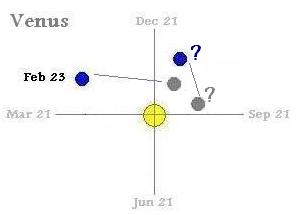
| |
 |
 Spaceweather featured the Venus/Moon conjunction of Feb 23 on its home page, with photographic results. The
position of Venus for an Earth in a stalled or reversed orbit would show Venus also in the SW sky, if Venus were
also stalled. Why would it not be, as it is more directly in the path of Planet X, which comes between the Earth
and Sun during its passage. Per the Zetas, this is what occurred. Venus has an orbital period of 224 days,
compared to Earth with 365 days. Thus it moves more rapidly. By Jan-Feb, 2004 it was arriving at a
confrontation point with Planet X, now in its orbit path, and would likewise have stalled going into that point,
giving a stalled Earth a similar viewing angle from the one anticipated for Feb 23. Conjunctions between the
crescent Moon and Venus are frequent, with slight differences in spite of the radically different placement of
Venus in its orbit. Note that in the photos from Feb 23, 2004, Venus is almost consistently appearing above the
point expected.
Spaceweather featured the Venus/Moon conjunction of Feb 23 on its home page, with photographic results. The
position of Venus for an Earth in a stalled or reversed orbit would show Venus also in the SW sky, if Venus were
also stalled. Why would it not be, as it is more directly in the path of Planet X, which comes between the Earth
and Sun during its passage. Per the Zetas, this is what occurred. Venus has an orbital period of 224 days,
compared to Earth with 365 days. Thus it moves more rapidly. By Jan-Feb, 2004 it was arriving at a
confrontation point with Planet X, now in its orbit path, and would likewise have stalled going into that point,
giving a stalled Earth a similar viewing angle from the one anticipated for Feb 23. Conjunctions between the
crescent Moon and Venus are frequent, with slight differences in spite of the radically different placement of
Venus in its orbit. Note that in the photos from Feb 23, 2004, Venus is almost consistently appearing above the
point expected.

From the Spaceweather web site:
Sky watchers saw a lovely sight after the sun set on Feb. 23rd: Venus and the crescent Moon side by side.
Jerry Etzkorn on Vancouver Island, B.C., Canada

John Stetson at Sebago Lake, Maine

Joseph M. Golebieski of Dover Township, NJ

Michael Blackburn of Boise, Idaho

Andrew Chatman of Pittsford, NY

Bob Montanaro at the Sebastian Inlet State Park, Florida

Rémi Boucher of Sherbrooke (Qc), Canada
